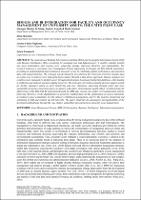Chapter BIM-GIS and BI Integration for Facility and Occupancy Management of University Assets: The UNITO Pilot Case
| dc.contributor.author | Di Giuda, Giuseppe Martino | |
| dc.contributor.author | Accardo, Daniele | |
| dc.contributor.author | Gasbarri, Paola | |
| dc.contributor.author | Meschini, Silvia | |
| dc.contributor.author | Tagliabue, Lavinia Chiara | |
| dc.contributor.author | Scomparin, Laura | |
| dc.date.accessioned | 2024-04-02T15:46:14Z | |
| dc.date.available | 2024-04-02T15:46:14Z | |
| dc.date.issued | 2023 | |
| dc.identifier | ONIX_20240402_9791221502893_60 | |
| dc.identifier.issn | 2704-5846 | |
| dc.identifier.uri | https://library.oapen.org/handle/20.500.12657/89091 | |
| dc.description.abstract | The integration of Building Information Modelling (BIM) and Geographic Information System (GIS) with Business Intelligence (BI) is promising for managing vast and diffused assets. It enables valuable insights into asset performance and resource uses, supporting savings, improved efficiency, and sustainability. The research proposes a web-based Asset Management System application (AMS-app) via BIM-GIS-BI integration, providing an updated digital representation of university assets by combining spatial, performance, and operation data with related analytics. The AMS-app was developed in the context of the University of Turin's strategic plan as a pilot case to improve asset management procedures through a data-driven approach. Indeed, campuses are complex assets managed by multiple actors through still document-based and fragmented databases, often leading to ineffective and untimely decision-making processes. The AMS-app represents a valuable decision support system for facility managers aimed at asset monitoring and user experience improving through better and more sustainable decisions concerning space, occupancy, and indoor environmental quality (IEQ). To demonstrate the effectiveness of the BIM-GIS-BI integration through the AMS-app, several case studies were implemented with the following objectives: (i) the digitalization of university building data, (ii) the optimization of courses timetables according to space availability, (iii) the optimal workstations management, and (iv) the analysis, monitoring and optimizing of IEQ and comfort via IoT networks. The paper illustrates the advantages and applicability of the developed methodology through the case studies, and further developments in university asset management | |
| dc.language | English | |
| dc.relation.ispartofseries | Proceedings e report | |
| dc.subject.classification | thema EDItEUR::U Computing and Information Technology::UT Computer networking and communications::UTV Virtualization | |
| dc.subject.other | Asset Management System | |
| dc.subject.other | BIM-GIS integration | |
| dc.subject.other | Business Intelligence | |
| dc.subject.other | Information management | |
| dc.title | Chapter BIM-GIS and BI Integration for Facility and Occupancy Management of University Assets: The UNITO Pilot Case | |
| dc.type | chapter | |
| oapen.identifier.doi | 10.36253/979-12-215-0289-3.41 | |
| oapen.relation.isPublishedBy | bf65d21a-78e5-4ba2-983a-dbfa90962870 | |
| oapen.relation.isbn | 9791221502893 | |
| oapen.series.number | 137 | |
| oapen.pages | 12 | |
| oapen.place.publication | Florence |

